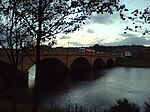Wellington Suspension Bridge
1830 establishments in ScotlandBridges across the River Dee, AberdeenshireBridges completed in 1831Bridges in AberdeenCategory A listed buildings in Aberdeen ... and 6 more
Chain bridgesFormer toll bridges in ScotlandListed bridges in ScotlandPedestrian bridges in ScotlandSuspension bridges in the United KingdomUse British English from March 2017

The Wellington Suspension Bridge (also known as the Chain Bridge and Craiglug Bridge) is a suspension bridge crossing the River Dee from Ferryhill to Craiglug in Aberdeen, north east Scotland. Designed by Captain Samuel Brown and the Aberdeen City Architect John Smith, it was opened to pedestrians in November 1830 and to traffic in May 1831. The chain bridge was closed in 1984 to vehicles and then pedestrians in 2002, but was restored in 2006/07 and pedestrian use was re-instated in 2008.
Excerpt from the Wikipedia article Wellington Suspension Bridge (License: CC BY-SA 3.0, Authors, Images).Wellington Suspension Bridge
Aberdeen City Tullos
Geographical coordinates (GPS) Address Nearby Places Show on map
Geographical coordinates (GPS)
| Latitude | Longitude |
|---|---|
| N 57.135244 ° | E -2.094648 ° |
Address
AB11 9AJ Aberdeen City, Tullos
Scotland, United Kingdom
Open on Google Maps





